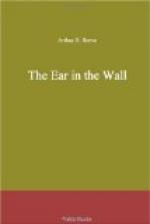It was almost incredible, but that glowing mass of powder seemed literally to be sinking, sinking right down into the cold steel. In tense silence we waited. On the ceiling we could see the reflection of the molten mass in the cup which it had burned for itself in the cold steel plate.
At last it fell through to the lower piece of steel, on which it burnt itself out—fell through as the burning roof of a frame building might have fallen into the building.
Neither Carton nor I spoke a word, but as we now cautiously advanced with Kennedy and peered over the steel plate we instinctively turned to Craig for an explanation. Carton seemed to regard him as if he were some uncanny mortal. For, there in the steel plate, was a hole. As I looked at the clean-cut edges, I saw that it was smaller but identical in nature with that which we had seen in the safe in Langhorne’s office.
“Wonderful!” ejaculated Carton. “What is it?”
“Thermit,” was all Kennedy said, as just a trace of a smile of satisfaction flitted over his face.
“Thermit?” echoed Carton, still as mystified as before.
“Yes, an invention of a chemist named Goldschmidt, of Essen, Germany. It is composed of iron oxide, such as conies off a blacksmith’s anvil or the rolls of a rolling-mill, and powdered metallic aluminum. You could thrust a red-hot bar into it without setting it off, but when you light a little magnesium powder and drop it on thermit, a combustion is started that quickly reaches fifty-four hundred degrees Fahrenheit. It has the peculiar property of concentrating its heat to the immediate spot on which it is placed. It is one of the most powerful oxidizing agents known, and it doesn’t even melt the rest of the steel surface. You see how it ate its way directly through this plate. Steel, hard or soft, tempered, annealed, chrome, or Harveyized—it all burns just as fast and just as easily. And it’s comparatively inexpensive, also. This is an experiment Goldschmidt it fond of showing his students—burning holes in one—and two-inch steel plates. It is the same with a safe—only you need more of the stuff. Either black or red thermit will do the trick equally well, however.”
Neither of us said anything. There was nothing to say except to feel and express amazement.
“Someone uncommonly clever or instructed by someone uncommonly clever, must have done that job at Langhorne’s,” added Craig. “Have you any idea who might pull off such a thing for Dorgan or Murtha?” he asked of Carton.
“There’s a possible suspect,” answered Carton slowly, “but since I’ve seen this wonderful exhibition of what thermit can do, I’m almost ashamed to mention his name. He’s not in the class that would be likely to use such things.”




